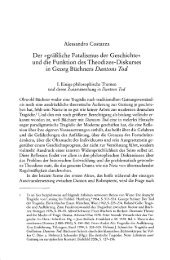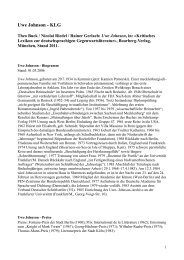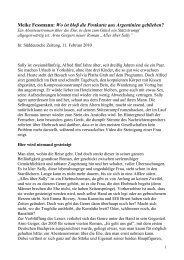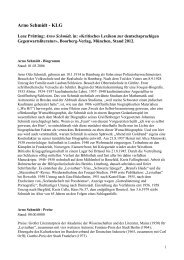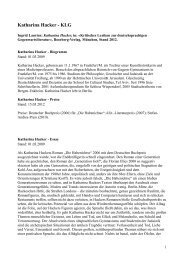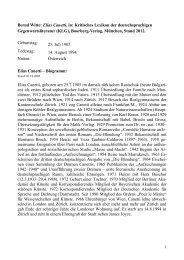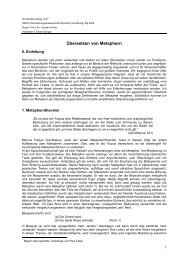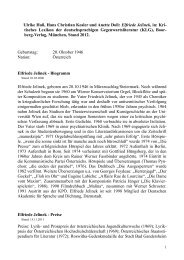Current Opinion in Investigational Drugs
Current Opinion in Investigational Drugs
Current Opinion in Investigational Drugs
You also want an ePaper? Increase the reach of your titles
YUMPU automatically turns print PDFs into web optimized ePapers that Google loves.
44 <strong>Current</strong> <strong>Op<strong>in</strong>ion</strong> <strong>in</strong> <strong>Investigational</strong> <strong>Drugs</strong> 2006 Vol 7 No 1<br />
both an <strong>in</strong>tensity- and duration-dependent manner [10•]. Thus,<br />
the susta<strong>in</strong>ed, <strong>in</strong>tense nociception associated with adjuvant<br />
arthritis may have sufficiently <strong>in</strong>hibited opioid analgesia<br />
tolerance development for morph<strong>in</strong>e analgesia to have<br />
rema<strong>in</strong>ed significant, at least over the 2-week period. Agents<br />
exemplify<strong>in</strong>g other central mechanisms of analgesia (eg, the 5-<br />
HT and noradrenal<strong>in</strong>e re-uptake <strong>in</strong>hibitor imipram<strong>in</strong>e (2.5<br />
mg/day), the excitatory am<strong>in</strong>o acid antagonist ketam<strong>in</strong>e (20<br />
mg/day), and the anticonvulsant gabapent<strong>in</strong> (10 mg/day))<br />
were <strong>in</strong>active (Table 3). Similar to tonic nociceptive pa<strong>in</strong>, the<br />
data suggest that high-efficacy 5-HT1A receptor activation<br />
produces an analgesia with chronic nociceptive pa<strong>in</strong> that is<br />
rivaled only, if at all, by morph<strong>in</strong>e-like opioids.<br />
Chronic neuropathic pa<strong>in</strong><br />
In a model of peripheral neuropathic pa<strong>in</strong>, rats undergo a<br />
unilateral chronic constriction <strong>in</strong>jury of the common sciatic<br />
nerve and demonstrate a lowered threshold for von Frey<br />
filament stimulation to <strong>in</strong>duce paw withdrawal [33]. A 2-week<br />
<strong>in</strong>fusion of morph<strong>in</strong>e, ketam<strong>in</strong>e or imipram<strong>in</strong>e produced a<br />
slight, non-significant <strong>in</strong>crease of the ipsilateral reduced<br />
threshold <strong>in</strong> sal<strong>in</strong>e-treated rats (17 g), while gabapent<strong>in</strong> exerted<br />
a significant effect (Table 3). F-13640 produced a larger, highly<br />
significant <strong>in</strong>crease, suggest<strong>in</strong>g robust efficacy <strong>in</strong> this model<br />
[15•]. This effect on ipsilateral threshold was behaviorally<br />
specific, <strong>in</strong> that F-13640 did not modify the contralateral<br />
threshold <strong>in</strong> sal<strong>in</strong>e-treated rats (69 g).<br />
In a model of central neuropathic pa<strong>in</strong>, rats received a<br />
photochemical, ischemic <strong>in</strong>jury of sp<strong>in</strong>al cord dorsal segments<br />
L3 to L5 and developed allodynic responses to cutaneous<br />
stimulations such as von Frey filament application, a gentle<br />
brush or a cold spray [34]. Interest<strong>in</strong>gly, and as with sciatic<br />
nerve constriction, subcutaneously <strong>in</strong>fused morph<strong>in</strong>e,<br />
ketam<strong>in</strong>e, imipram<strong>in</strong>e and gabapent<strong>in</strong> <strong>in</strong>creased the von Frey<br />
threshold to some extent, although not significantly so; these<br />
agents also exerted no significant effect <strong>in</strong> response to a gentle<br />
brush or a cold spray (Table 3). In contrast, F-13640 robustly<br />
<strong>in</strong>hibited all three responses [15•]. The effects of F-13640 grew<br />
<strong>in</strong> the course of the 2-week treatment period, demonstrat<strong>in</strong>g<br />
<strong>in</strong>verse analgesic tolerance.<br />
The acute <strong>in</strong>jection of F-13640, as well as that of morph<strong>in</strong>e,<br />
can counteract allodynic responses to von Frey filament<br />
stimulation <strong>in</strong> rats susta<strong>in</strong><strong>in</strong>g a chronic constriction <strong>in</strong>jury of<br />
the <strong>in</strong>fra-orbital nerve (IoN-CCI), a model of trigem<strong>in</strong>al<br />
neuropathic pa<strong>in</strong> [35]. The effects of F-13640 <strong>in</strong> this model<br />
are aga<strong>in</strong> behaviorally specific [36]. In these rats, morph<strong>in</strong>e<br />
<strong>in</strong>fusion <strong>in</strong>itially produces a robust, significant analgesia to<br />
which complete tolerance develops after 2 weeks; the effects<br />
of F-13640 <strong>in</strong>creased rather than decl<strong>in</strong>ed dur<strong>in</strong>g the 2-week<br />
period, aga<strong>in</strong> demonstrat<strong>in</strong>g <strong>in</strong>verse tolerance [37•,38,39,40•].<br />
Collectively, these data suggest that high-efficacy 5-HT1A<br />
receptor activation may produce exceptionally powerful and<br />
susta<strong>in</strong>ed, 'symptomatic' analgesia with chronic neuropathic<br />
pa<strong>in</strong> of peripheral or central orig<strong>in</strong>.<br />
Pre-emptive and curative-like analgesia<br />
Much as opioids <strong>in</strong>duce a hyperalgesia and tolerance that<br />
may outlast µ-opioid receptor activation for a long time (eg,<br />
a year [10•,41]), the signal-transduction concept suggests<br />
that a neuropharmacological manipulation that generates<br />
the <strong>in</strong>verse of opioid actions should <strong>in</strong>duce analgesia (and<br />
cont<strong>in</strong>ue to demonstrate <strong>in</strong>verse tolerance) long after its<br />
implementation has been discont<strong>in</strong>ued.<br />
Rats were <strong>in</strong>fused with 0.63 mg/day of F-13640 for 8 weeks<br />
start<strong>in</strong>g 24 h before the sp<strong>in</strong>al cord <strong>in</strong>jury described<br />
previously; with all three cutaneous stimulations the<br />
treatment effect persisted unabated for 2 months follow<strong>in</strong>g<br />
discont<strong>in</strong>uation of treatment [42]. These data, together with<br />
the consideration that F-13640 is effective <strong>in</strong> neuropathic<br />
pa<strong>in</strong> regardless of its peripheral or central orig<strong>in</strong>, suggest<br />
that high-efficacy 5-HT1A receptor activation may<br />
powerfully 'pre-empt' pa<strong>in</strong> ensu<strong>in</strong>g from neuronal damage,<br />
such as that result<strong>in</strong>g from surgical nerve <strong>in</strong>jury or diabetes.<br />
To explore this suggestion, rats hav<strong>in</strong>g susta<strong>in</strong>ed sp<strong>in</strong>al cord<br />
<strong>in</strong>jury and hav<strong>in</strong>g fully developed allodynia were then<br />
<strong>in</strong>fused with F-13640 (0.63 mg/day) for 56 days. The<br />
treatment <strong>in</strong>creas<strong>in</strong>gly alleviated and eventually normalized<br />
the allodynic responses, thereby demonstrat<strong>in</strong>g <strong>in</strong>verse<br />
tolerance. More importantly, dur<strong>in</strong>g the 70-day period that<br />
ensued, the effects of F-13640 persisted, demonstrat<strong>in</strong>g an<br />
unprecedented 'curative-like' action on allodynic pa<strong>in</strong> [40•].<br />
It rema<strong>in</strong>s to be determ<strong>in</strong>ed whether these pre-emptive and<br />
curative-like actions are mediated by the neuron-protective<br />
and astroglial reaction-<strong>in</strong>hibitory effects that 5-HT1A<br />
agonists may produce <strong>in</strong> ischemic bra<strong>in</strong> tissue [43].<br />
Although it might be of <strong>in</strong>terest to similarly exam<strong>in</strong>e the<br />
potential pre-emptive and curative-like actions of morph<strong>in</strong>e,<br />
ketam<strong>in</strong>e, imipram<strong>in</strong>e and gabapent<strong>in</strong>, the absence of<br />
significant symptomatic effects with these agents <strong>in</strong> the<br />
sp<strong>in</strong>al cord <strong>in</strong>jury model has prevented the research group<br />
from do<strong>in</strong>g so. Indeed, any such pre-emptive actions<br />
reported so far have concerned pa<strong>in</strong> parameters that<br />
respond <strong>in</strong> a symptomatic manner to the agents be<strong>in</strong>g<br />
considered [44,45]. Prom<strong>in</strong>ent among these agents are<br />
opioids, and the largest symptomatic effects observed to<br />
date with cont<strong>in</strong>uous, 2-week <strong>in</strong>fusion of any comparable<br />
analgesic <strong>in</strong> any model of neuropathic pa<strong>in</strong> were obta<strong>in</strong>ed<br />
with 5 mg/day of morph<strong>in</strong>e <strong>in</strong> the IoN-CCI model [37•,38].<br />
As <strong>in</strong>dicated, soon after the <strong>in</strong>itiation of morph<strong>in</strong>e <strong>in</strong>fusion,<br />
a robust analgesia occurs <strong>in</strong> this model, to which tolerance<br />
develops with<strong>in</strong> 2 weeks. At that stage, discont<strong>in</strong>uation of<br />
morph<strong>in</strong>e <strong>in</strong>fusion does not afford analgesia, and <strong>in</strong> fact<br />
causes hyperallodynia [53].<br />
Tolerability<br />
Although the data discussed previously allow assessment of<br />
the comparative therapeutic potential of F-13640 relative to<br />
currently available treatments to a considerable extent, the<br />
evidence available so far offers only little <strong>in</strong> the way of an<br />
evaluation of the relative tolerability of the compound.<br />
Regard<strong>in</strong>g the opioids, however, one issue stands out; it is<br />
now recognized that the chronic use of opioids <strong>in</strong>duces an<br />
analgesic tolerance that not only limits, or dissipates their<br />
therapeutic usefulness, but is also accompanied by<br />
hyperalgesia and opioid-<strong>in</strong>duced pa<strong>in</strong> [10•,13,14]. In<br />
addition to the well-known side effects of opioids, this drug<strong>in</strong>duced<br />
pa<strong>in</strong> may become 'excruciat<strong>in</strong>g', thus severely




